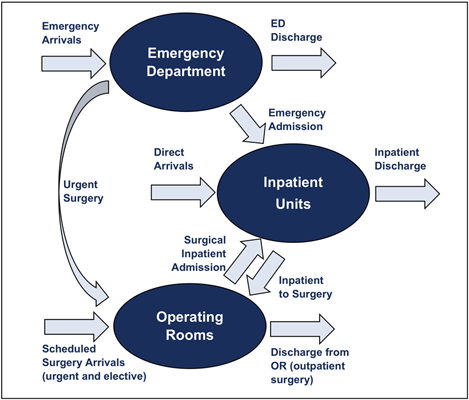Mathematical Tools that Could Help Hospitals Optimise their Operations
The Centre for Healthcare Engineering would be pleased to open discussion (contacts) with interested parties to further develop mathematical optimization tools for industry needs and priorities, or to pursue other projects building from the core expertise of our faculty affiliates or previous/current projects. Depending on the scope and objectives of the desired project, we can also help hospitals connect with trusted implementation partners who are more focused on rapid implementation.
From the proud history of operations research by faculty and students affiliated with the Centre, a number of numeric simulation models have been developed for the evaluation of healthcare systems and operations. These optimisation tools can be adapted for application at different hospitals where cost savings and efficiency improvements are sought, and further refined to improve reliability or address new problems. The decision support tools include:
- Surgical Flow Model
This simulation model has already been successfully implemented at more than 15 hospitals across Canada. It has been used to test scenarios for efficiency, impact of process deviation or schedule changes, or to test proposals for bed reallocation or OR capacity adjustment.
More info… - Hospital Flow Model

This patient flow model is an extension of the Surgical Flow Model and covers the ED, OR and inpatient beds. This simulation model can be used to examine how decisions affect flow throughout the hospital, or to assess the impact of schedules, policies or surge on surgical throughput, bed occupancy and ED wait times.
More info… - Bed Capacity Model
This simulation model estimates patient bed capacity requirements in a hospital during a typical week. This tool can be used to evaluate bed allocation between services, to smoothen patient demand for beds by adjusting OR schedules, or to test scenarios for the impact of changes to patient care pathways, patient demand or surgical schedules.
More info… - Hospital Porter Model
This simulation model captures the flow of porter tasks from request to completion or cancellation. It can be used to compute performance measures, to assess and adjust porter schedule to meet demand, or to evaluate the impact of changes on overall flow. - Clinic Scheduling Model
This scheduling tool allows hospitals to find the optimal time and location for each of their clinics based on needs and priorities. It can be adapted to maximize resource efficiency, to align inter-departmental demands, or to minimize disruption of current schedules.
More info…
Each of this suite of tools can be customized to meet requirements and configurations of specific hospitals.

